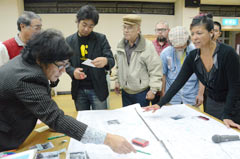Student researches history of black soldiers’ community in Koza

In December 2012 at the Teruya Community Center in Okinawa City, Eriko Ikehara (far right), a graduate student at UC Berkeley, listens to stories from locals about the black soldiers’ community.
February 7, 2013 Ryukyu Shimpo
Eriko Ikehara, a 49 year-old graduate school student at University of California, Berkeley, has researched the history of the black soldiers’ community that existed from the 1950s until about 1976 in the Teruya district of what was formerly Koza City (currently Okinawa City). Until this January, she based herself in Teruya for about three months in order to gather information from local people who remember those days.
Ikehara has looked into the circumstances in which a black soldiers’ community came to be formed in Okinawa, where locals were also suppressed under U.S. military rule. At the same time, back in the United States the civil rights movement was gaining momentum among the blacks discriminated against by white Americans. She said, “I think that there was something universal in Teruya that should be cherished.” Ikehara refers to herself as an “Uchina-half” – a black woman born between an Uchinanchu mother and a black father. She spent her childhood in the Teruya district, known as the town of black soldiers, so that is where she has her roots.
During her stay, as a project to record the history of the community, she carried out her research with local people at the community center, in pubs and in the Gintengai shopping mall. In a meeting held in the street next to what used to be the black soldiers’ town, she heard about incidents such as robbery and acts of violence towards women by the soldiers. At the same time, she came to understand that there was a feeling of solidarity between the black soldiers and Uchinanchu against the strong grip of the oppressor. For example, she heard that a group of black soldiers carried out a movement with the Zengunro (All-Okinawa Base Workers Union) against the Vietnam War.
Ikehara said, “Koza, is a town that came to life after the Battle of Okinawa. It has an image of rock music, white people’s culture, but it also has another image, that of the soul music belonging to the black people, but this aspect of the city has not been examined in any depth. There is certainly a negative image involving crime, but I think that the black people and Uchinanchu had something in common as people who were discriminated against.”
She said, “Verifying history is the first step toward a better future. I will research the stories of the black soldiers who stayed in Okinawa at that time, and I want to let the Koza Crossroads serve as a junction for friendship between the United States and Okinawa.”
(English translation by T&CT, Mark Ealey)
Previous Article:Satiparo ritual held on Miyako-jima
Next Article:Okinawan traditional horse racing to be revived
[Similar Articles]
- Koza X MiXitopia Research Center opens in Gintengai Shopping Arcade
- “I understood how both the Uchinanchu and U.S. military felt.” Okinawan musician who grew up down the street from military base shares his story on the 49th anniversary of the Koza Riot
- “Okinawa’s struggle on the edge of non-violence” discussed at Naha symposium 50 years after Koza riot, links to the present explored
- Walking tour of Koza resumes after three-year hiatus, including the taco stand featured in the movie “Miracle City Koza”
- Eisa Dance Monument set up at Koza Athletic Park
 Webcam(Kokusai Street)
Webcam(Kokusai Street)


